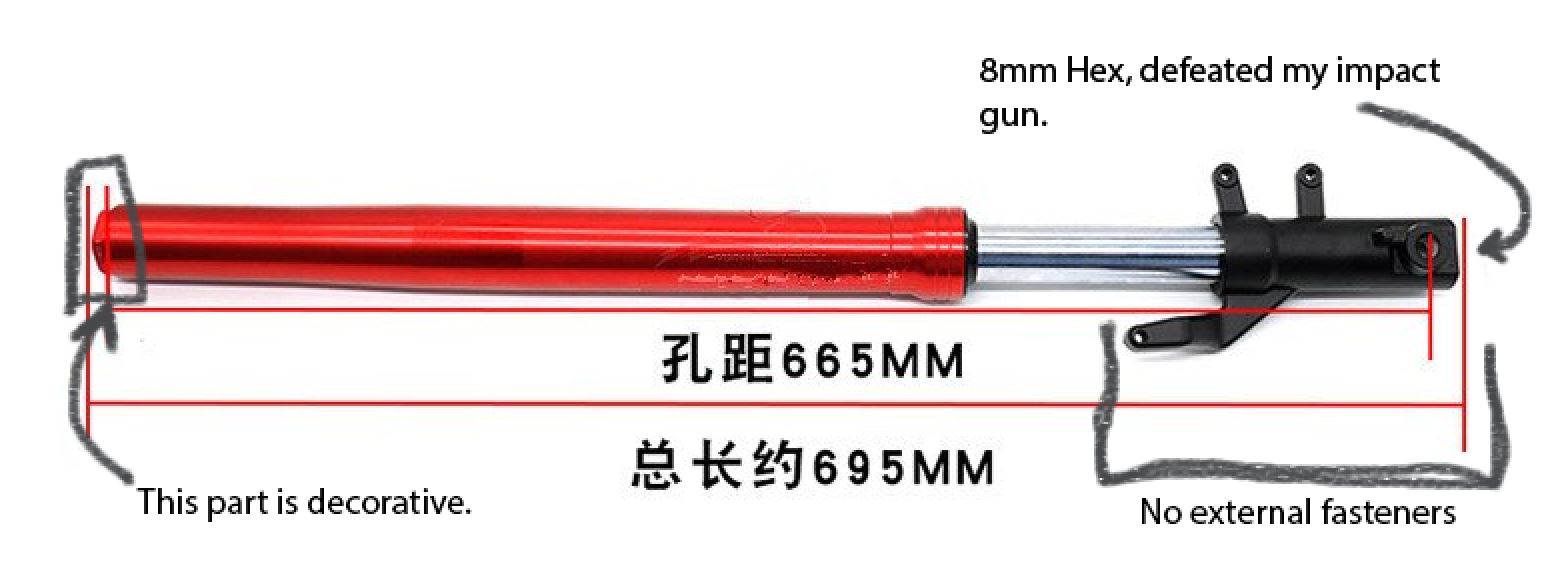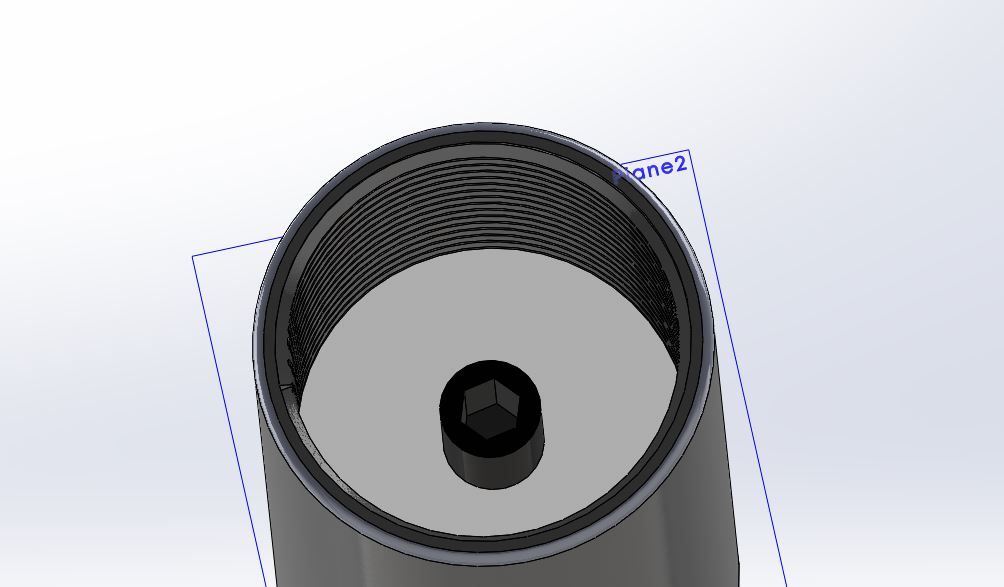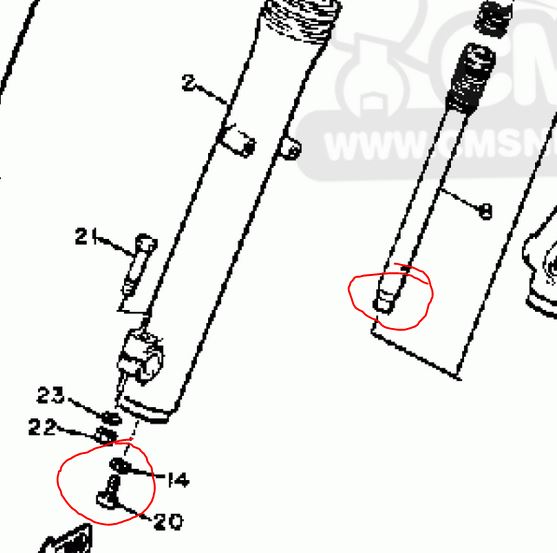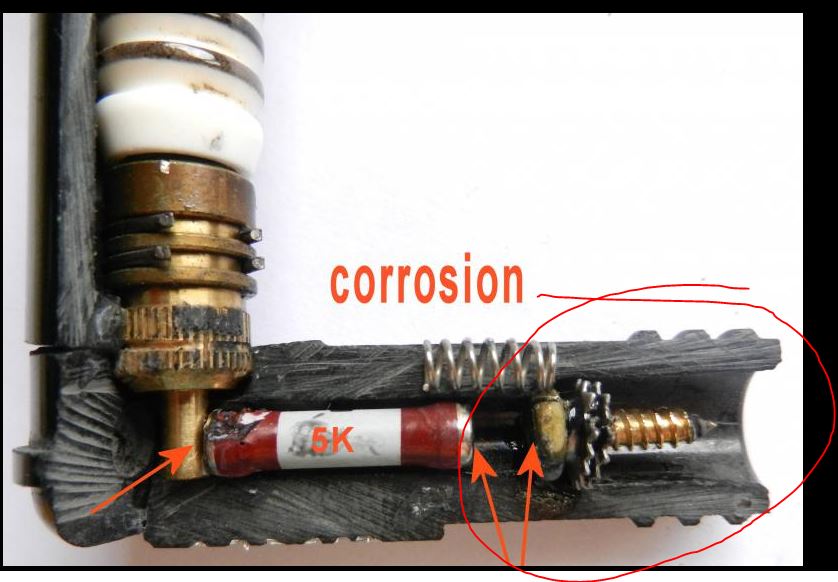Alllllright. I've gotta document this here for posterity.
2020 Hellcat forks. They are not the same construction as the Vader forks at all. On Friday, I got an a-frame ladder and a 4" wide ratchet strap expecting to change my fork oil. Oh boy was I ever mistaken.
For reference, you can see the general construction of a boom vader fork (at least the endcap and damping rod)
here.
I went into the project expecting the same. Nope. I... did my usual and sis not take any pictures, so I will assemble what I found from stock images of chinese forks.

The top cap comes off, and nothing to to it. Nothing attached either.
Inside, I found the heart of the operation. A single 6mm allen head bolt.

With forks mounted in triple, axle through bottoms, I started to loosen the allen head bolt. It just spun.
Okay, maybe it's like the XJ where the internal plug is seated with o-rings in grooves, and it just requires some force to push the plug out. SO I dropped one fork, put it on the ground, loosely threaded the top cap to prevent parts flying out with the force of 1000 angry squirrels, and bottomed out the fork. Nope. Nothing. Not one iota of movement.
Hmmmmm. Maybe spring tension is holding an internal fastener? Removed fork cap, bottomed out the fork, spun the bolt to the left..... nothing. Just spun. Could hear a spring spinning too. Hmmmmm. Okay, what's on the bottom? Maybe it's like an 80s conventional fork where the damper rod valving is secured through the bottom.

Okay, interesting, there is a deep-set 8mm bolt perpendicular to the axle running up into the body. I found an 8mm allen that fit, put that on my pneumatic impact and.... chug-chug-chug-chug... nothing.
Okay, maybe there's loctite? Heated the bottom tube to 150F, just to soften it a little. chug-chug-chug-chug... nothing. This will clearly take a breaker bar and a bench vise. I have one, but not the other (sturdy mounted bench vise with a fork tube holder jaw set). No spare forks in case I bend the tube, so I gave up and put them back together. I have been defeated. That said, I have not bottomed out these forks like many others have reported.I'm at a loss as to how to get these apart.
Okay, onto the other issue I have been fighting. Breakup at 7k rpm. When it hits the trouble spot, it feels like the engine dies, then the momentum from being in gear and moving bump starts it, then it dies, cycle repeats perpetually. I never had this issue with the stock exhaust, only after I added the free flowing aftermarket exhaust. At first, I thought it was just a lean issue. SO I started on a quest for main jetting. I went:
- 118 needle clip positions 2, 3 ,4
- 115 needle 2, 3, 4
- 120, needle clip 3
- 122 needle clip 3, 4
- 125 needle clip 3, 4
None of these helped. I am at 4400 ft elevation and other ZS190 owners report using 118-120 at about 1000ft above sea level, so the 125 is definitely rich. Even then, it should be shooting backfires, spitting, etc even though its rich as a pig. Nope, same cutting behavior.
Well, maybe a vacuum leak. SO I set it to idle and did quick spurts of brake cleaner at:
- the carb manifold connection.... no extra revs.
- The carb boot to manifold.... no extra revs.
Nope, not a leak on the intake. Maybe an exhaust leak? SO I checked the header. Tight. No carbon deposits, no evidence of leak. I used a genuine Grom gasket.
If it were compression, the bike would not start easily nor idle. That's ruled out. So I have ruled out the suck, the squeeze, and the juice. ALl that's left is the spark.
Re-gapped the plug, no dice.
New plug? No dice.
I suspect the ignition coil is the culprit. It's the stock hellcat coil with loose-fitting rubber insulator and stamped steel outer boot. It honestly looks like what you would find on a cheap lawn mower or roto-tiller, or an American yardwork engine from the 60's.
A word on CDI ignition:
Quote:
|
Originally Posted by elprocus.com
When the gate opens and dumps all the current into the primary side, it saturates the low-voltage side of the transformer and sets up a short but immensely magnetic field. As the field reduces gradually, a large current in the primary windings forces the secondary windings to produce extremely high voltage.
However, the voltage is now so high that it can arc through the air, so rather than being absorbed or retained by the transformer, the charge travels up the plug wire and jumps the plug gap.
|
A word on ignition demand:
Quote:
|
Originally Posted by agriculture.com
The ignition system is considered to be passive. The spark plug only takes from the ignition coil what it needs to create an arc across the plug’s electrodes. It must be recognized that ignition demand is determined by the following:
- Cylinder pressure
- Engine speed
- Air-fuel ratio
- Ignition timing
- Spark plug gap
Cylinder pressure is not meant to be confused with compression ratio. Cylinder pressure is the cumulative result of the load on the engine in relation to the volumetric efficiency and mixture strength. Compression ratio is a design function of the difference in the volume of the bore with the piston at bottom dead center, compared to when it is at top dead center. Cylinder pressure and ignition demand are constantly changing with engine load.
At idle, the required energy to arc the spark plug is very low since the cylinder pressure is minimal. This is due to the throttle being almost closed, the engine rpm being low, and the fact that there is no load on the engine. |
Here is what I am feeling, courtesy of some guy on youtube. This I think confirms the spark issue. It starts around the 1:46 mark.
So the plan of action:
- Re-jet back to 120m clip 4. Likely still a touch rich, but a leaner mixture is easier to ignite (hence why you get pings/knocks when lean)
- Swap in the ZS190 coil, which has a normal plastic and rubber insulated boot. I have already gone through and done the "righty tighty" on the wire at both ends for this coil and plug boot. Typically these just have a pointed screw at each end of the wire to tighten. The screw tends to "fray" the inner conductor of the plug wire, wrapping itself in the copper and making contact.

- If that does not work, I will try an NGK iridium plug CR9EIX. It has a much smaller electrode tip (.6mm vs 3mm on the CR9E) which requires less voltage to jump the gap due to a more concentrated ionization force about the smaller tip. Either the stator is not charging the CDI capacitor fast enough at high RPM to generate sufficient voltage (seems unlikely since RPM and voltage output should be proportional) or there is still a weak link that takes less voltage to jump compared to the cylinder under compression.
Oh and about the plug cap shown above... our plug caps should be non-resistor type, since the plugs used have internal resistors. That plug cap is more applicable to my XJ internally since it uses non-resistor plugs.
The coil that came with my ZS190 ohms-out at .5-Ohm primary and 9K secondary. Haven't take the one off the hellcat to measure since it's been cold and rainy.